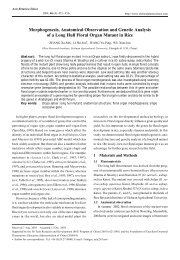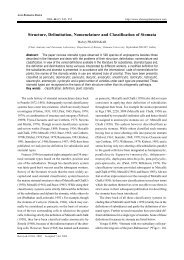Abiotic and biotic stresses and changes in the lignin ... - ResearchGate
Abiotic and biotic stresses and changes in the lignin ... - ResearchGate
Abiotic and biotic stresses and changes in the lignin ... - ResearchGate
Create successful ePaper yourself
Turn your PDF publications into a flip-book with our unique Google optimized e-Paper software.
21<br />
470<br />
471<br />
472<br />
473<br />
474<br />
475<br />
476<br />
477<br />
478<br />
479<br />
480<br />
481<br />
482<br />
483<br />
484<br />
485<br />
486<br />
487<br />
488<br />
489<br />
490<br />
491<br />
492<br />
493<br />
494<br />
As <strong>in</strong> TW, <strong>the</strong> chemical <strong>and</strong> anatomical characteristics of <strong>the</strong> CW are <strong>the</strong> results<br />
of various altered molecular <strong>and</strong> physiological factors. Unravell<strong>in</strong>g <strong>the</strong>se factors will be<br />
necessary to underst<strong>and</strong> <strong>the</strong> mechanisms <strong>in</strong>volved <strong>and</strong> elucidate lign<strong>in</strong> biosyn<strong>the</strong>sis <strong>in</strong><br />
wood. Many studies have already identified prote<strong>in</strong>s <strong>and</strong> genes potentially responsible<br />
for <strong>the</strong> different characteristics of CW, <strong>in</strong>clud<strong>in</strong>g <strong>the</strong> high amount of lign<strong>in</strong>.<br />
The comparison of prote<strong>in</strong>s <strong>in</strong> CW <strong>and</strong> <strong>in</strong> <strong>the</strong> opposite normal wood showed that<br />
<strong>the</strong> presence of a dioxygenase related to <strong>the</strong> biosyn<strong>the</strong>sis of anthocyan<strong>in</strong>s<br />
(leucoanthocyanid<strong>in</strong> dioxygenase) might contribute to <strong>the</strong> colour of this reddish wood<br />
(Gion et al., 2005).<br />
O<strong>the</strong>r prote<strong>in</strong>s abundant <strong>in</strong> this type of wood are: 1-am<strong>in</strong>ocyclopropane-1-<br />
carboxylate oxidase, an enzyme that catalyzes <strong>the</strong> conversion of 1-am<strong>in</strong>ocyclopropane-<br />
1-carboxylate to ethylene; glutam<strong>in</strong>e syn<strong>the</strong>tase <strong>and</strong> fructok<strong>in</strong>ase, enzymes <strong>in</strong>volved <strong>in</strong><br />
<strong>the</strong> assimilation of nitrogen <strong>and</strong> carbon; malate dehydrogenase, an enzyme of <strong>the</strong> Krebs<br />
cycle (Plomion et al., 2000); glyceraldehyde-3-phosphate dehydrogenase (G3PDH), an<br />
enzyme related to energy production <strong>and</strong> metabolism; <strong>and</strong> α-tubul<strong>in</strong>, <strong>the</strong> ma<strong>in</strong><br />
component of cortical microtubules (Le Provost et al., 2003).<br />
O<strong>the</strong>r studies have reported on prote<strong>in</strong>s possibly more directly <strong>in</strong>volved <strong>in</strong> <strong>the</strong><br />
differential accumulation of lign<strong>in</strong>. A polypeptide correspond<strong>in</strong>g to a laccase-type of<br />
polyphenol oxidase, which is <strong>in</strong>volved <strong>in</strong> <strong>the</strong> biosyn<strong>the</strong>sis of lign<strong>in</strong>, has higher activity<br />
<strong>in</strong> develop<strong>in</strong>g xylem <strong>in</strong> <strong>the</strong> CW of Picea sitchensis, as compared to non-compressed<br />
wood (McDougall, 2000).<br />
Twenty-six prote<strong>in</strong>s whose expression was correlated with an <strong>in</strong>crease <strong>in</strong> <strong>the</strong><br />
degree of compression were identified <strong>in</strong> P<strong>in</strong>us p<strong>in</strong>aster, <strong>in</strong>clud<strong>in</strong>g two methylat<strong>in</strong>g<br />
enzymes <strong>in</strong>volved <strong>in</strong> lign<strong>in</strong> biosyn<strong>the</strong>sis - COMT <strong>and</strong> CCoAOMT – <strong>and</strong> members of <strong>the</strong><br />
S-adenosyl-L-methion<strong>in</strong>e syn<strong>the</strong>tase gene family. In addition to be<strong>in</strong>g enzymes







